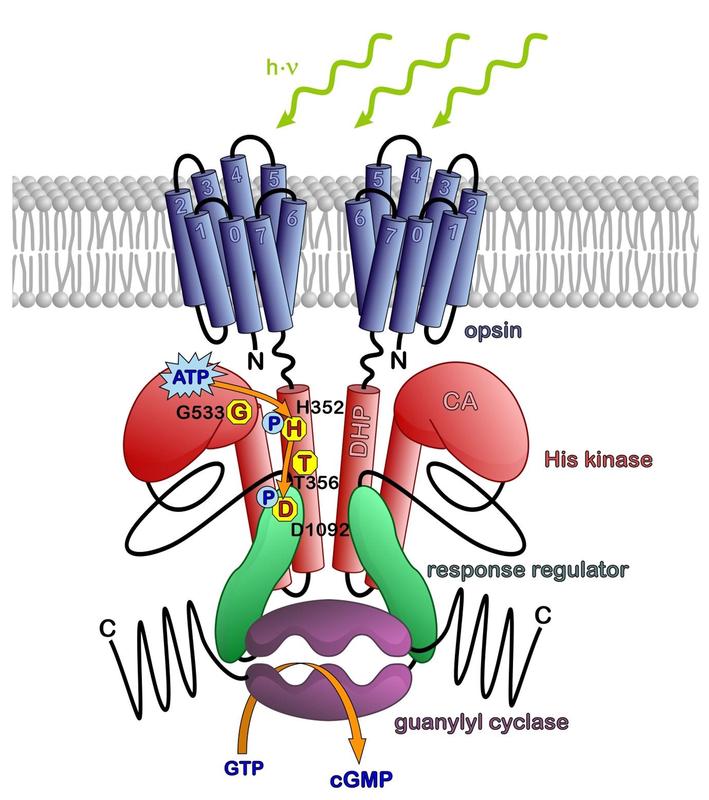The Algae’s Third Eye

Two molecules of the new light sensor 2c-cyclop, which in darkness produces the messenger cGMP. Green light inhibits the signal chain. Image: Shiqiang Gao / Armin Hallmann, Georg Nagel
Just like land plants, algae use sunlight as an energy source. Many green algae actively move in the water; they can approach the light or move away from it. For this they use special sensors (photoreceptors) with which they perceive light.
The decades-long search for these light sensors led to a first success in 2002: Georg Nagel, at the time at Max-Planck-Institute of Biophysics in Frankfurt/M, and collaborators discovered and characterized two so-called channelrhodopsins in algae.
These ion channels absorb light, then open up and transport ions. They were named after the visual pigments of humans and animals, the rhodopsins.
Now a third “eye” in algae is known: Researchers discovered a new light sensor with unexpected properties. The research groups of Professor Armin Hallmann (Bielefeld University) and Professor Georg Nagel (Julius-Maximilians-Universität Würzburg, JMU) report this finding in the journal BMC Biology.
Light reduces cGMP production
The surprise: The new photoreceptor is not activated by light but inhibited. It is a guanylyl cyclase which is an enzyme that synthesizes the important messenger cGMP.
When exposed to light, cGMP production is severely reduced, leading to a reduced cGMP concentration – and that's exactly what happens in the human eye as soon as the rhodopsins there absorb light.
The newly discovered sensor is regulated by light and by the molecule ATP. Such “two component systems” are already well known in bacteria, but not in higher evolved cells.
The researchers have named the new photoreceptor “Two Component Cyclase Opsin”, 2c-cyclop for short. They found it in two green algae, in the unicellular Chlamydomonas reinhardtii as well as in the multicellular Volvox carteri.
Function shown in oocytes and algae
“For many years there has been genetic data from which we could conclude that in green algae there must be many more rhodopsins than the two previously characterized,” explains Georg Nagel. Only in Chlamydomonas reinhardtii twelve protein sequences are assigned to the opsins, which are the precursors of rhodopsins.
“So far, nobody could demonstrate the function of these light sensors,” says Nagels co-researcher Dr. Shiqiang Gao. Only the research groups from Bielefeld and Würzburg have succeeded in doing so: They have installed the new rhodopsin in oocytes of the toad Xenopus laevis and in the spherical alga Volvox carteri. In both cases, its function could be shown and characterized.
Perspectives for Optogenetics
The authors believe that the 2c-Cyclop light sensor offers new opportunities for optogenetics. With this methodology, the activity of living tissues and organisms can be influenced by light signals. By means of optogenetics, many basic biological processes in cells have already been elucidated. For example, it provided new insights into the mechanisms of Parkinson's disease and other neurological diseases. She also brought new insights into diseases like autism, schizophrenia, and depression or anxiety disorders.
The JMU researcher Georg Nagel and the biophysicist Peter Hegemann (Humboldt Universität Berlin) are among the pioneers of optogenetics: They discovered the channelrhodopsins and found that the light-controlled ion channels from algae can be incorporated into animal cells and then controlled with light. For this achievement, both – together with other researchers – have received multiple awards.
Prof. Dr. Georg Nagel, Chair of Botany I – Molecular Plant Physiology and Biophysics, University of Würzburg, T +49 931 31-86143, georg.nagel@botanik.uni-wuerzburg.de
“Two-component cyclase opsins of green algae are ATP-dependent and light-inhibited guanylyl cyclases”, Yuehui Tian, Shiqiang Gao, Eva Laura von der Heyde, Armin Hallmann, and Georg Nagel, BMC Biology, 6 December 2018, 16: 144 , https://doi.org/10.1186/s12915-018-0613-5
Media Contact
More Information:
http://www.uni-wuerzburg.deAll latest news from the category: Life Sciences and Chemistry
Articles and reports from the Life Sciences and chemistry area deal with applied and basic research into modern biology, chemistry and human medicine.
Valuable information can be found on a range of life sciences fields including bacteriology, biochemistry, bionics, bioinformatics, biophysics, biotechnology, genetics, geobotany, human biology, marine biology, microbiology, molecular biology, cellular biology, zoology, bioinorganic chemistry, microchemistry and environmental chemistry.
Newest articles

A ‘language’ for ML models to predict nanopore properties
A large number of 2D materials like graphene can have nanopores – small holes formed by missing atoms through which foreign substances can pass. The properties of these nanopores dictate many…

Clinically validated, wearable ultrasound patch
… for continuous blood pressure monitoring. A team of researchers at the University of California San Diego has developed a new and improved wearable ultrasound patch for continuous and noninvasive…

A new puzzle piece for string theory research
Dr. Ksenia Fedosova from the Cluster of Excellence Mathematics Münster, along with an international research team, has proven a conjecture in string theory that physicists had proposed regarding certain equations….



